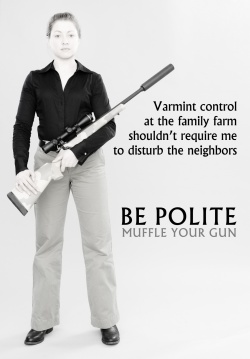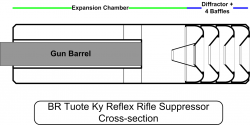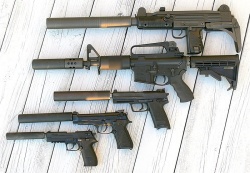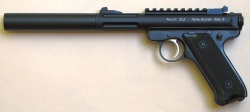Suppressor
A suppressor or sound moderator is a device attached to a firearm to reduce the amount of noise and flash generated by firing the weapon. It generally takes the form of a cylindrically-shaped metal tube that is fit onto the barrel of the firearm, with various internal mechanisms to reduce the sound of firing by slowing the escaping propellant gas, and sometimes by reducing the velocity of the bullet. Suppressors are also popularly known as silencers, though no suppressor completely eliminates the noise of discharging a firearm.[1] The muffler for internal combustion engines was developed in parallel with the firearm suppressor by Hiram Maxim, using many of the same techniques to provide quieter-running engines.
Contents[hide] |
[edit] History

Early suppressors were created around the beginning of the 20th century by a number of inventors. American inventor Hiram Maxim is credited with inventing and selling the first commercially successful models circa 1902. Maxim called his device the trademarked name Maxim Silencer. Later this style of device would be widely adapted to internal combustion engines to generate the muffler, still called a silencer in the UK. The term silencer has since fallen out of favor among the firearms industry, being replaced with the more accurate term sound suppressor or just suppressor. Common usage, in newsprint and in non-technical usage favors the technically inaccurate, but historically earlier term that was used, silencer.
Suppressors were regularly used by American Office of Strategic Services (OSS) agents during World War II, who favored the newly-designed High Standard HDM .22 Long Rifle pistol. "Wild Bill" Donovan, director of the OSS, demonstrated the pistol for President Franklin D. Roosevelt at the White House. According to OSS research chief Stanley Lovell[3], Donovan (an old and trusted friend of the President) was waved into the Oval Office, where Roosevelt was dictating a letter. While Roosevelt finished his letter, Donovan turned his back and fired ten shots into a sandbag he had brought with him, announced what he had done and handed the smoking gun to the astonished president.
[edit] Design and construction

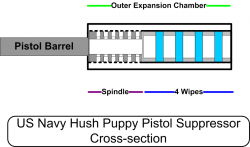
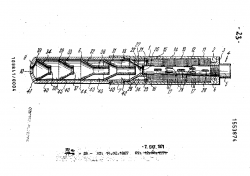
The suppressor is typically a hollow cylindrical piece of machined metal (usually steel or aluminum) containing expansion chambers that attaches to the muzzle of a pistol, submachinegun or rifle. These "can"-type suppressors (so-called as they resemble a beverage can), may be detached by the user and attached to a different firearm of the same caliber. Another type is the "integral" suppressor, which consists of expansion chambers surrounding the barrel. The barrel is pierced with openings or "ports" which bleed off gases into the chambers. This type of suppressor is part of the firearm, and maintenance of the suppressor requires that the firearm be at least partially disassembled.
Both types of suppressor reduce noise by allowing the rapidly expanding gases from the firing of the bullet to be briefly diverted or trapped inside a series of hollow chambers. The trapped gas expands and cools, and its pressure and velocity decreases as it exits the suppressor. The chambers are divided by either baffles or wipes (see below). There are typically at least four and up to perhaps fifteen chambers in a suppressor, depending on the intended use and design details. The engineering design of modern suppressors is analogous mathematically to the design of electrical filters, and many of the same techniques may be used to design either. Often, a single, larger expansion chamber is located at the muzzle end of a can-type suppressor, which allows the propellant gas to expand considerably and slow down before it encounters the baffles or wipes section of the suppressor.
Suppressors vary greatly in size and efficiency. One disposable type developed in the 1980s by the US Navy for 9 mm pistols is 150 x 45 mm (5.9 x 1.77 in) and is designed for six shots with standard ammunition or up to thirty shots with lower-powered subsonic (slower than the speed of sound) ammunition. The British Sterling suppressor is 350 mm (13.78 in) long and 75 mm (2.95 in) in diameter and will work effectively for hundreds of shots with standard ammunition.
[edit] Components
Baffles are circular metal dividers which separate the expansion chambers. Each baffle has a hole in its center to permit the passage of the bullet through the suppressor and towards the target. The hole is typically at least 0.04 inch / 1 mm larger than the bullet caliber to minimize the risk of the bullet hitting the baffle ("baffle strike"). Baffles are typically made of stainless steel, aluminum, titanium or alloys such as Inconel, and are either machined out of solid metal or stamped out of sheet metal. A few suppressors for low-powered cartridges such as the .22 Long Rifle have successfully used plastic baffles (certain models by Vaime and others[1]).
Baffles are separated by spacers, which keep them aligned at a specified distance apart inside the suppressor. Many baffles are manufactured as a single assembly with its spacer, and several suppressor designs have all the baffles attached together with spacers as a one-piece helical baffle stack. Modern baffles are usually carefully shaped to divert the propellant gases effectively into the chambers. This shaping can be a slanted flat surface, canted at an angle to the bore, or a conical or otherwise curved surface. One popular technique is to have alternating angled surfaces through the stack of baffles.
Baffles come in several designs. M, K, Z, and Ω(Omega) are the most prevalent. M-type is the crudest and composes an inverted cone. K forms slanted obstructions diverging from the sidewalls, creating turbulence across the boreline. Z is expensive to machine and includes "pockets" of dead airspace along the sidewalls which trap expanded gasses and hold them thereby lenghtening the time that the gasses cool before exiting. Omega is an advanced design combining elements of all three previous designs. Omega forms a series of spaced cones drawing gas away from the boreline, incorporates a scallopped mouth creating cross-bore turbulence, which is in turn directed to a "mouse-hole" opening between the baffle stack and sidewall.
Baffles usually last for a significant number of firings. Propellant gas heats and erodes the baffles, causing wear, which is worsened by high rates of fire. Aluminum baffles are seldom used with automatic weapons, because service life is unacceptably short. Some modern suppressors using steel or high-temperature alloy baffles can endure extended periods of fully-automatic fire without damage. The highest-quality rifle suppressors available today have a claimed service life of greater than 30,000 rounds. While some manufacturers even claim service life in excess of 50,000 rounds, which exceeds the service life of most firearm barrels, this has not been confirmed.
Wipes are inner dividers intended to touch the bullet as it passes through the suppressor, and are typically made of rubber, plastic or foam. Each wipe may either have a hole drilled in it before use, a pattern stamped into its surface at the point where the bullet will strike it, or it may simply be punched through by the bullet. Wipes typically last for a small number of firings (perhaps no more than five) before their performance is significantly degraded. While many suppressors used wipes in the Vietnam era, most modern suppressors eschew wipes to extend the time between servicing of the device.
"Wet" suppressors or "wet cans" use a small quantity of water, oil, grease or water-based wire-pulling lubricant in the expansion chambers to cool the propellant gases and reduce their volume. The coolant lasts only a few shots before it must be replenished, but while it lasts it can greatly increase the effectiveness of the suppressor. Water is most effective, due to its high heat of vaporization, but it can run or evaporate out of the suppressor. Water-based wire-pulling lubricant gel is more convenient as it does not run or drip. Grease, while messier and less effective than water, can be left in the suppressor indefinitely without losing effectiveness. Oil is the least effective and least preferable, as it runs while being as messy as grease, leaving behind a fine mist of condensed oil after each shot. Water-based gels, such as wire-pulling lubricant gel, are a good compromise; they offer the efficacy of water with less mess, as they do not run or drip. However, they take longer to apply, as they must be cleared from the bore of the suppressor to ensure a clear path for the bullet (grease requires this step as well). Generally, only pistol suppressors are shot wet, as rifle suppressors handle such high pressure and heat that the liquid is gone within 1-3 shots. Many manufacturers will not warranty their rifle suppressors for "wet" fire, as some feel this may even result in a dangerous over-pressurization of the silencer.
Liners made of various materials may be used to line the chambers and dissipate or cool the gases; these include metal mesh and steel wool. These are somewhat more effective than empty chambers, but less effective than wet designs [1]. However, steel wool degrades very rapidly, usually within ten shots; metal mesh may last for hundreds or thousands of shots of semi-automatic fire, or significantly less for full-automatic fire. Like wipes, such packing materials are rarely found in modern suppressors.
Wipes, packing materials and purpose-designed wet cans have been generally abandoned in 21st-century suppressor design because they decrease overall accuracy and require excessive cleaning and maintenance. The instructions from several manufacturers state that their suppressors need not be cleaned at all. Furthermore, legal changes in the United States during the 1980s and 1990s made it much more difficult for end-users to legally replace internal silencer parts, and the newer designs reflect this reality.
[edit] Suppressors and silencers
Many who use such devices have adopted the term suppressor as superior to the term silencer, as no firearm suppressor is truly silent. Others believe that suppressor is more politically correct, and does not carry the same "hitmen and mobsters" stigma that the general public has applied to the term silencers.
Functionally, a suppressor is not meant to completely silence a firearm, but to make its sound unrecognizable. When a round is fired, very hot gases exit the barrel quickly, creating the distinctive gunshot sound. When a suppressor is attached to the weapon, it gives the gases more time to expand and cool. No suppressor can completely eliminate the sound of firing a firearm. Even subsonic bullets make distinct sounds by their passage through the air and striking targets, and supersonic bullets produce a small sonic boom, resulting in a ballistic crack as the mach wave reflects off adjacent structures or geography. Semi-automatic firearms also make a distinct noise as their action cycles, ejecting the fired cartridge case and loading a new round. Thus, the ideal suppressed weapon would be either a single-shot or a manually-operated repeating firearm such as a bolt-action rifle (see Firearms for use with suppressors below). Effective suppressors either use a large total suppressor volume, or a moderately large volume plus many baffles, or wipes. It is possible to design a very small and compact suppressor with wipes which effectively silences a pistol; these suppressors have a lifetime of as few as five shots and typically no more than a few magazines of ammunition. Most suppressors designs trade reduced total volume and weight for somewhat louder noise, which is still significantly tactically useful. The optimum point for any particular design depends on the suppressor's intended use.
[edit] Advanced types
In addition to attempting to initially contain and slowly release the gas pressure associated with muzzle blast or reducing pressure through the use of coolant mediums, the properties of the sound waves generated by the muzzle blast are considered and dealt with in advanced suppressor designs. In these designs, effects known as frequency shifting and phase cancellation (or destructive interference) are used in an attempt to make the suppressor quieter. These effects are achieved by separating the flow of gases and causing them to collide with each other again. The intended effect of frequency shifting is to shift audible sound waves frequencies into ultrasound (above 20 kHz), beyond the range of human hearing. Phase cancellation occurs when similar sound wave frequencies encounter each other 180° out of phase, canceling the amplitude of the wave and so eliminating the pressure variations perceived as sound.
Utilizing either effect to an advantage requires that the suppressor be designed with specific properties of the muzzle blast in mind. For example, the velocity of the sound waves are a major factor. This figure can change significantly between different cartridges and barrel lengths.
Thus, in order for maximum effectiveness to be achieved, the suppressor must be "tuned" for a specific cartridge/barrel length combination. This can be done through the use of either a fixed or adjustable baffle design. While it may sound daunting, any weapon that needs to provide such exceptional sound suppression is almost certainly going to be manufactured in small quantities and issued only for mission profiles critical enough to make such efforts worthwhile.
However, these concepts are controversial because muzzle blast creates broadband noise rather than pure tones, and phase cancellation in particular is therefore extremely difficult (if not impossible) to achieve. Some suppressor manufacturers claim to utilize phase cancellation in their designs, but these claims are highly controversial and generally unsupported from a scientific perspective.
[edit] Effectiveness
[edit] Sources of firearm noise
The portrayal of silenced firearms in movies has produced the misconception that silencers completely eliminate the sound of firing, or reduces it to a quiet whistling or "phut" sound. Some films even depict silenced 7.62 mm NATO sniper rifles — a weapon that creates a supersonic boom — making only a quiet sound. However, this is in most cases very far from the truth, as in fact, the decreased noise can still be heard for some distance, depending on the surrounding conditions (ambient noise, echoes from surrounding structures, etc.). This is because when a gun is fired, multiple sounds are possibly made. There are five major categories of suppressed fire noise: action, blast, sonic signature, impact, and operator. Some of these are present in all instances, others depend wholly on the specific mechanics of the weapon employed.
In order of timing:
- Action noise required to ignite the round.
- Muzzle blast resulting from the discharge of propellant from the end of the barrel.
- Sonic signature of the projectile in flight (supersonic velocity rounds).
- Action noise in some firearm variants as the spent round is discharged and a fresh round reloaded.
- Impact noise created as the projectile finds terminal impact.
Obviously, some of these sounds are much louder than others. The two loudest sounds in a gunshot are typically the muzzle blast and the sonic signature. Multiple techniques are used to address each of these sounds, but the suppressor itself is capable of addressing muzzle blast, sonic signature (through integral gas bleed, reducing the projectile to subsonic) and the ability to cancel the mechanical action noise through Nielsen device manipulation, canceling the ejection cycle.
Another important factor in sound signature suppression is the muzzle velocity of the ammunition. In weapons firing supersonic bullets, most often rifles, the supersonic bullet itself produces a loud and very sharp sound (a tiny sonic boom) as it travels downrange, referred to as "ballistic crack". For this reason, it is more difficult to reduce the total sound signature of these firearms effectively. Subsonic ammunition reduces sound report, but at the cost of lower velocity, often resulting in decreased range and effectiveness on the target.
Another solution is to lower the muzzle velocity of a supersonic bullet before it leaves the barrel. Some suppressor designs do this by allowing gas to bleed off along the length of the barrel before the projectile exits; others contain wipes that use friction to slow the bullet before exiting. The wipes generally wear out and lose effectiveness after relatively few shots. Silenced sniper rifles used by military marksmen and police counter-terror units usually use special sub-sonic ammunition and added on or integral silencers to reduce the sound of the weapon's report. While this makes the accurate range only 300-400 meters, which may make this type of weapon of minimal use in some military sniping contexts, this may be acceptable for counter-terror units, because they often engage their targets at close range.[4]
[edit] Real world data
Live tests by independent reviewers of numerous commercially available suppressors find that even low caliber unsuppressed .22 LR firearms produce gunshots over 160 decibels.[5] In testing, most of the suppressors reduced the volume to between 130 and 145 dB, with the quietest suppressors metering at 117 dB. The actual suppression of sound ranged from 14.3 to 43 dB, with most data points around the 30 dB mark.
Comparatively, ear protection commonly used while shooting provides 18 to 32 dB of sound reduction at the ear.[6] Further, chainsaws, rock concerts, rocket engines, pneumatic drills, small firecrackers, and ambulance sirens are rated at 100 to 140 dB.
While some consider the noise reduction of a suppressor significant enough to permit safe shooting without hearing protection ("hearing safe"), noise-induced hearing loss may occur at 85 time weighted average decibels or above if exposed for a prolonged period,[7] and suppressed gunshots regularly meter above 130 dB. However, the US Occupational Safety and Health Administration uses 140 dB as the "safety cutoff" for impulse noise, which has led most US manufacturers to advertise sub-140 dB suppressors as "hearing safe."
[edit] Limitations of dB meter effectiveness
dB testing measures only the peak sound "pressure" noise, not duration or frequency. Limitations of dB testing become apparent in a comparison of sound between a .308 caliber rifle and a .300 Winchester Magnum rifle. The dB meter will show that both rifles produce the same decibel level of noise. Upon firing these rifles, however, it is clear that the .300 Winchester Magnum sounds much louder. What the decibel meter doesn't show is that although both rifles produce the same peak sound pressure level (SPL), the .300 Winchester Magnum holds its peak duration longer. The .300 Winchester Magnum sound remains at full value longer, while the .308 goes to peak and falls off more quickly. dB meters fail in this and other regards when being used as the principal means to determine suppressor capability.[8]
[edit] Caliber versus volume
The caliber and power of the bullet/cartridge being suppressed is also an important factor. Generally, equal quality suppressors can quiet the report of a smaller caliber bullet more effectively than a larger caliber bullet. This is because the exhaust gases can move more quickly through the exit hole necessary for larger caliber bullets. Likewise, cartridges which produce higher pressures and more gases, such as those used in rifles, will also generally be louder than those which produce less pressure and fewer gases, such as handgun cartridges. In a gunshot, the sound of the report (the combination of the sonic boom, the vacuum release, and burn of powder) will almost always be louder than the sound of the action cycling of an auto-loading firearm. Alan C. Paulson, a renowned firearms specialist, claimed to have encountered an integrally suppressed .22 LR that had such a quiet report,[9] although this is somewhat uncommon.
Because of the limited stopping power of less powerful cartridges,[10] movie scenes in which an attacker fires a near-silent shot that instantly kills the victim are generally unrealistic.
[edit] Subsonic ammunition versus volume
In weapons firing supersonic bullets, the supersonic bullet itself produces a loud and very sharp sound as it leaves the muzzle in excess of the speed of sound and gradually reducing speed as it travels downrange. This is a small sonic boom, and is referred to in the firearm field as "ballistic crack". Subsonic ammunition reduces this sound, but at the cost of lower velocity, often resulting in decreased range and effectiveness on the target. Military marksmen and police units may use this ammunition to maximize the effectiveness of their silenced rifles. While the range may be decreased when using subsonic rounds, this may be acceptable for specialized situations, where the absolute minimum amount of noise is required.[4]
However, the numeric effectiveness of subsonic rounds is, again, misrepresented by media. Independent testing of commercially available firearm suppressors with commercially available subsonic rounds has found that .308 subsonic rounds decreased the volume at the muzzle 10 to 12 dB when compared to the same caliber of suppressed supersonic ammunition.[5] When combined with suppressors, the subsonic .308 rounds metered between 121 and 137 dB.
This ballistic crack depends on the speed of sound, which in turn depends mainly on air temperature. At sea level, an ambient temperature of 70 °F (21 °C), and under normal atmospheric conditions, the speed of sound is approximately 1,140 feet (350 m) per second (347 m/s). Bullets that travel near the speed of sound are considered transonic, which means that the airflow over the surface of the bullet, which at points travels faster than the bullet itself, can break the speed of sound. Pointed bullets which gradually displace air can get closer to the speed of sound than round nosed bullets before becoming transonic.
Because merely reducing the propellant in a cartridge to get a slower bullet would lead to less stopping power, special cartridges have been developed specifically to maximize the energy available when used with a suppressor. These cartridges use very heavy bullets to make up for the energy lost by keeping the bullet subsonic. A good example of this is the .300 Whisper cartridge, which is formed from a necked-up .221 Remington Fireball cartridge case. The subsonic .300 Whisper fires up to a 250 grain (16.2 g), .30 caliber bullet at about 980 feet (300 m) per second (298 m/s), generating about 533 ft·lbf (722 J) of energy at the muzzle. While this is similar to the energy available from the .45 ACP pistol cartridge, the reduced diameter and streamlined shape of the heavy .30 caliber bullet provides far better external ballistic performance, improving range substantially.
9x19mm Parabellum, a very popular caliber for suppressed shooting, can use almost any factory-loaded 147 gr (9.5 g) weight round to achieve subsonic performance. These 147 gr weight bullets typically have a velocity between 900 and 980 feet (300 m) per second (275 and 300 m/s), which is less than the common 1140 ft/s speed of sound.
Russian 9x39mm ammo had a high subsonic Ballistic coefficient, high retained downrange energy, high Sectional density, and moderate recoil. All elements combined make this a very attractive choice for Close Quarters Combat firearms.
Instead of using subsonic ammunition, one can also lower the muzzle velocity of a supersonic bullet before it leaves the barrel. Some suppressor designs, referred to as "integrals", do this by allowing gas to bleed off along the length of the barrel before the projectile exits. However, as of 2010, the best-known weapons with integral suppressors such as MP5SD and VSS Vintorez/AS Val fire subsonic cartridges and use integral suppressors for the sole purpose of reducing the weapon's length rather than to slow down an inherently supersonic cartridge.
[edit] Identification
Aside from reductions in volume, suppressors also tend to alter the sound to something that is not identifiable as a gunshot. This reduces or eliminates attention drawn to the shooter (hence the Finnish expression: "A silencer does not make a marksman silent, but it does make him invisible"). This is especially true in cases where there are other sources of ambient noise, such as in an urban environment. Suppressors are particularly useful in enclosed spaces where the sound, flash and pressure effects of a weapon being fired are amplified. Such effects may disorient the shooter, affecting situational awareness, concentration and accuracy, and can permanently damage hearing very quickly.
As the suppressed sound of firing is overshadowed by ballistic crack, observers can be deceived as to the location of the shooter, often from 90 to 180 degrees from his actual location. However, counter-sniper tactics can include Gunshot Location Detection Systems, where sensitive microphones are coupled to computer algorithms, and use the ballistic crack to detect and localize the origin of the shot. The U.S. Boomerang system is currently the only deployed example.
[edit] Other advantages
Suppressors are particularly useful in enclosed spaces where the sound, flash and pressure effects of a weapon being fired are amplified. Such effects may disorient the shooter, affecting concentration and accuracy, and can permanently damage hearing very quickly. A short-barreled rifle like the M4 Carbine fired inside a room or hallway is extremely loud when unsuppressed and the reports from an unsilenced weapon could temporarily deafen the law enforcement officers or soldiers. The suppressor also has the often-neglected benefit of reducing muzzle flash by as much as 90%. This is very important as much fighting takes place at night, and soldiers are commonly trained to identify and shoot at muzzle flashes in combat. Silencers are also useful for target shooting, as the reduced noise can prevent hearing damage to the user of a firearm, and prevents complaints about noise from neighbors when using an outdoor range.
There are also many other advantages in using a suppressor that have nothing to do with sound.
Hunters using centerfire rifles find suppressors bring various important benefits that outweigh the extra weight and resulting change in the firearm's center of gravity. The most important advantage of a suppressor is the hearing protection for the shooter as well as his/her companions. There are many hunters who have suffered permanent hearing damage due to someone else firing a high-caliber gun too closely without a warning. By reducing noise, recoil and muzzle-blast, it also enables the firer to follow through calmly on his first shot and fire a further carefully aimed shot without delay if necessary. Wildlife of all kinds are often confused as to the direction of the source of a well-suppressed shot. In the field, however, the comparatively large size of a centerfire rifle suppressor can cause unwanted noise if it bumps or rubs against vegetation or rocks, and many users cover them with neoprene sleeves.
Suppressors can increase the precision of a rifle, as they strip away propellant gases from around the projectile in a uniform fashion. This reduces the potential of propellant gases to upset the base of the bullet before it enters free flight. When the bullet finally exits the suppressor it does so through a flat end cap, which is essentially an optimally crowned muzzle.
Suppressors reduce firing recoil significantly, primarily by diverting and trapping the propellant gas. Propellant mass is generally a fraction of the projectile mass, but it exits the muzzle at multiples of the projectile velocity, and since recoil energy is a function of mass times velocity squared the elimination of the propellant recoil can be significant. Paulson et al., discussing low-velocity pistol calibers, suggest the recoil reduction is around 15%.[1] With high-velocity calibers recoil reduction runs in the range of 20-30%.[11] The added weight of the suppressor — normally 300 to 500 grams — also contributes to the reduction of the recoil. Further, the pressure against the face of each baffle is higher than the pressure on its reverse side, making each baffle a miniature "pneumatic ram" which pulls the suppressor forward on the weapon, contributing a counter recoil force.
A suppressor also cools the hot gases coming out of the barrel enough that most of the lead-laced vapor that leaves the barrel condenses inside the suppressor, reducing the amount of lead that might be inhaled by the shooter and others around them. However, in auto-loading actions this might be offset by increased back pressure which results in propellant gas blowing back into a shooter's face through the chamber during case ejection.
[edit] Legal status
Legal regulation of suppressors varies widely around the world. In some nations, such as Finland and France, some or all types of suppressor are essentially unregulated and may be bought "over the counter" in retail stores or by mail-order as they are considered a great help, along with hearing protection, to preserve the hearing of the user and any onlookers. In these same countries, however, the firearms themselves are strictly controlled.
In Canada, a device to muffle or stop the sound of a firearm is a "prohibited device" under the Criminal Code.[12] A prohibited device is not inherently illegal in Canada but it does require an uncommon and very specific prohibited device license for its possession, use, and transport. Suppressors cannot be imported into the country.[13]
The United States tax and strictly regulate their manufacture and sale. It is legal in thirty-five of the fifty states for an individual to possess and use a suppressor; however, one must go through the National Firearms Act process administered by the ATF. Such transfers also require a Federal tax payment of US $200 and a thorough background check. Since suppressors are inexpensive to build, with models retailing in other countries for under US $40[14], the licensing and transfer tax restrictions result in suppressors being very expensive in the U.S., with similar models selling for US$400[15] not including transfer fees. Several states and municipalities explicitly ban any civilian possession of suppressors.
In the United Kingdom, sales of suppressors fall into four categories of use. For replica and air weapons, the purchase of a suppressor requires no license and in most cases, no identification requirement. For shotguns, these will probably require the presentation of the buyer's shotgun certificate but will not be recorded. For a small- or full-bore rifle, the firearm certificate (FAC) will need to show permission for the purchase of a suppressor and also the gun for which it is intended. All firearms certificates have the firearm and calibre approved by the police and annotated to the document before a silencer may be purchased. Police forces usually approve applications for a silencer for hunting and target shooters, as the risks of litigation for personal injury, especially high-tone deafness resulting from shooting-induced hearing loss, are significant; and noise pollution in general is a problem for shooting sports.
In Denmark, the Danish Weapons And Explosives Law makes the unlicensed possession of a suppressor illegal. A permit may be acquired from the local police, but permission is almost always denied. Only police and hunters with special permission for the emergency slaughtering of livestock inside buildings are allowed to use them.
In Sweden, suppressors are legal for hunting purposes, for some calibres. A license is required, but is normally always granted. In Austria, the purchase or possession of a suppressor is prohibited according to §17 of the Austrian Weapons Law. In Italy, the purchase or possession of a suppressor is prohibited except for military personnel. In New Zealand, no permits are required for the manufacture, sale, possession, or use of a suppressor.
[edit] Ammunition
Suppressors are most effective when the bullet's velocity does not exceed the speed of sound. At sea level, at an ambient temperature of 70 °F (21 °C) and under normal atmospheric conditions, the speed of sound is approximately 1100 feet per second (340 m/s). A bullet that breaks the sound barrier creates a sonic boom. For any further increase in velocity higher than the speed of sound, flight noise does not increase significantly. Supersonic flight noise may be reduced somewhat by using a projectile of smaller caliber. Bullets that travel near the speed of sound are considered transonic, which means that the airflow over the surface of the bullet, which at points travels faster than the bullet itself, can break the speed of sound. Pointed bullets which gradually displace air can get closer to the speed of sound than round nosed bullets before becoming transonic.
Special cartridges have been developed specifically to maximize the energy available when used with a suppressor. These cartridges use very heavy bullets to make up for the energy lost by keeping the bullet subsonic. A good example of this is the .300 Whisper cartridge, which is formed from a necked-up .221 Fireball cartridge case. The subsonic .300 Whisper fires up to a 250 grain (16.2 g), .30 caliber bullet at about 980 feet per second (298 m/s), generating about 533 ft·lbf (722 J) of energy at the muzzle. While this is similar to the energy available from the .45 ACP pistol cartridge, the reduced diameter and streamlined shape of the heavy .30 caliber bullet provides far better external ballistic performance, improving range substantially.
[edit] Firearm types
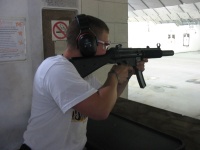
The type of gun also affects suppressor efficiency. Guns with the least leakage are best, so a sealed breech (e.g. bolt action or lever action) is preferable and can be suppressed to the point that the click as the striker or hammer falls is the loudest sound of firing. Most semiautomatic and fully-automatic firearms still produce a significant amount of noise from the gun cycling and the leak of high-velocity gas from the breech. Revolvers, due to the gap between the cylinder and barrel, cannot be made quiet. There are however, a few exceptions: The Nagant M1895 revolver uses an unusual cylinder that moves forward upon firing, and a special extended cartridge case which seals the gap between cylinder and barrel, making it suitable for use with a suppressor. While it seems that any semi-automatic pistol can be fitted with a suppressor, it is not as simple as threading the barrel and installing a suppressor. Most semiautomatic pistols of 9 mm Luger caliber or larger use a short recoil action. In this system, the slide and barrel both recoil for a short distance before the slide unlocks from the barrel and opens the breech. This keeps the breech sealed until the chamber pressure drops to a safe level.
Adding the mass of a suppressor to the barrel/slide combination will significantly alter the operation of the gun; in most cases, the added mass stops the slide from unlocking at all, and effectively turns the semiautomatic pistol into a single-shot weapon. This is not always undesirable, as the sound of the action cycling is often louder than the suppressed report. Nearly all short recoil designs are based on the John Browning-designed tilting barrel lockup, as used in the M1911, Browning Hi-Power and Glock pistols. This system uses a tilting barrel, which means that in addition to adding mass, the suppressor also adds rotational inertia, greatly resisting the force that tilts the barrel. Special mechanisms, called recoil boosters or Nielsen devices, are used to decouple the mass of the suppressor from the barrel. These devices consist of a sliding baffle in the rear of the suppressor that is forced back under the pressure of the powder gas, thus forcing the barrel backwards and unlocking the short recoil mechanism. Adding a recoil booster increases the complexity and cost of the suppressor, but enhances its ability to function in the semiautomatic mode.
Due to the difficulties of suppressing short recoil designs, suppressors are easier to add to smaller-caliber pistols, such as those chambered in .380 ACP, .32 ACP and .22 Long Rifle. Pistols using these cartridges are usually blowback designs with fixed barrels, which are easier to suppress. The most commonly suppressed firearms are .22 Long Rifle semiautomatic pistols and rifles, which allows them to be fired without the use of hearing protection, even with supersonic rounds. Specially-designed firearms with integral suppressors (e.g. the Welrod or De Lisle Carbine) provide the best overall result, as the suppressor can be fully telescoped to reduce the overall length of the gun, and the caliber can be chosen for maximum performance with the suppressor. The .45 ACP is an excellent choice, since the standard 230 grain (15 g) loading is both powerful and subsonic. Special cartridges are also available designed for use with suppressors. The .300 Whisper is the most common of these (see above).
[edit] References
- ↑ Cite error: Invalid
<ref>tag; no text was provided for refs namedPaulson1 - ↑ Parker, Firearm Suppressor Patents: Vol. 1 United States Patents, ISBN 1-58160-460-2
- ↑ Stanley Lovell, Of Spies and Stratagems, 1963.
- ↑ 4.0 4.1 "Modern sniper rifles" world.guns.ru, 2001-01-26.
- ↑ 5.0 5.1 Results Robert Silvers, 2005
- ↑ "Firearms and Hearing Protection | March 2007 | The Hearing Industry Resource" Hearingreview.com 2007-02-12.
- ↑ "nihl" Hearinglossweb.com
- ↑ dB in Principle and Practice, AWC Systems Technology April 2010
- ↑ Silencer: History and Performance, Volume 1 by Alan C. Paulson
- ↑ http://www.abaris.net/info/ballistics/hatcher-table.htm
- ↑ White, Mark "The Use of Sound Suppressors on High-Powered Rifles" Small Arms Review Vol. 1 No 7-9, 1998
- ↑ Criminal Code of Canada, Part III Firearms and other Weapons
- ↑ Importing a Firearm or Weapon Into Canada Canadian Border Services Agency
- ↑ Husssh Sound Moderators
- ↑ Paradigm Suppressors
